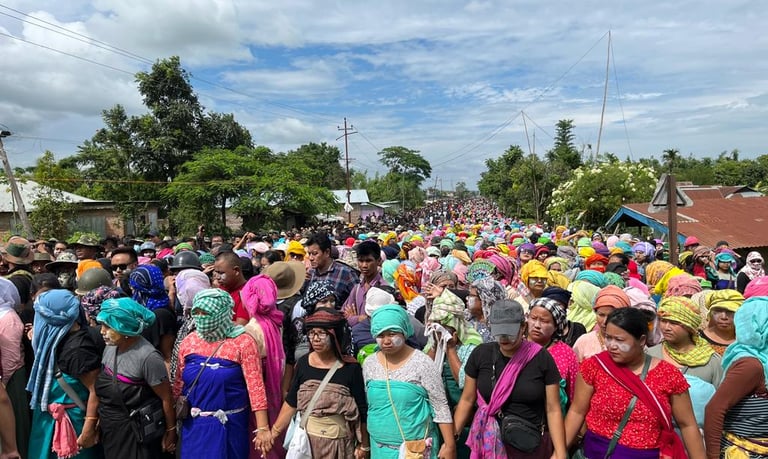How Editors’ Guild of India became a symbol of shame!
CONFLICT


Imphal: From the famed Washington Post to the British Broadcasting Corporation (BBC), from the Times of India to The Telegraph. No one is immune to criticism. Without a shadow of a doubt, the role of the media is inconceivably huge and is the engine that drives democracy forward, based on the quest for truth, justice and equality.
Upholding standard of accuracy, impartiality, and responsibility in their reporting and writing has been the hallmark of journalism since its advent. Yet, the very idea of communication, objectivity and fairness have been a subject of intense discussion and debate for centuries. For instance, the ‘proximity of news’: an incident that happened in Manipur, which is some 2500 km from Delhi, cannot be the lead story for most media organisations based in the national capital, unless it attracts the very idea of ‘news and events’ that happened in a remote corner of the country. With all the difficulties and struggle for survival in the face of growing social media platforms and continued pressures and scrutiny from the masses, the media has been reduced to just a mouthpiece or otherwise a propaganda piece of some biggies and corporations.
Forget about how the news is circulating in Western media on the present Russia-Ukraine conflict, filing an unbiased report from battlefields and small conflict areas like Manipur is one of the most dangerous and herculean tasks. In short, being unbiased is not just about gathering info from both sides but also truthfulness and authenticity of the story. You can’t write a story from an unwilling source.
Now, in the light of the so-called fact-finding report of the Editors’ Guild of India (EGI) on the violent ethnic clashes in Manipur, the very question of fairness and objective has cropped up again, regrettably for a fallacious reason. The style of writing and narratives of some of the Imphal-based newspapers and TV channels might, at times, have been exaggerated or misquoted about some events, but the so-called fact-finding report of the three-member team of the EGI on the violence is not only distasteful from the first page itself but has also shown total naivety on the issue and prejudice towards the Meiteis, which is one of the conflicting parties in the violence.
“It was not the mandate of the EGI team to examine the causes of the ethnic clashes in Manipur. However, it would be difficult to understand the media’s behaviour, without understanding the overall social and political context within which the ethnic violence took place,” is what the EGI claimed in the beginning. Well, the intent of the EGI, according to its first line, appeared to be genuine and acceptable. But the problem is that it diluted and broke its own ‘mandate’ by the second sentence, which says that “without understanding the overall social and political context”, you cannot launch a ‘fact-finding mission’ of the four-month reportage on violence by Manipur media in just merely three days.
Another glaring example of the EGI naivety is the ‘military coup’ in Myanmar that led to an inflow of refugees to both Mizoram and Manipur. The military coup in our eastern neighbour, although not the first time, took place only two years ago but the inflow of refugees in Mizoram and Manipur began nearly five decades ago. But as we understand, Myanmar is known as ‘a state of revolt’, according to Swedish journalist Bertil Lintner, because of its sheer number of militant organisations and rebellions against the Myanmar government since 1949. These unwanted illegal immigrants are necessarily not related to the military coup in that country. There might be over forty thousand in Mizoram, but the growth of villages from 164 numbers in 1969 to 460 in 2023 in Tengnoupal, from 179 to 721 in Kangpokpi respectively, and the growth of Tamenglong from 116 in 1969 to 146 in 2023, from 126 to 147 in Senapati, from 106 to 92 in Ukhrul district respectively cannot true if we are to believe EGI’s claim that the number is just over 4000 in Manipur.
Interestingly, most of the immigrants are Chins, the so-called cousins of Mizos and Kukis of Manipur. Why no other ethnic groups who are fighting the military junta coming to Manipur and Mizoram if there is a military coup in that country? A ludicrous part of the EGI’s report is that the team, of course, met many ‘Meitei journalists’ including Editors of prominent newspapers and TV channels, in Imphal but the so-called fact-finding report of 24-page hardly reflected any of the ideas they shared with. Rather, the report even claims that the tension between the majority Meiteis and minority Kuki-Chin-Zo communities already reached a ‘boiling point’ much before the violence that started on May 3.
An Editor of an English language newspaper, who wished not to be identified, while speaking to this correspondent, wondered how the EGI came to the conclusion that there was already a ‘boiling point’ of tension between the two communities. He agreed that there were many protests, strikes and dharna in the state, but not necessarily against any particular community. The journalist disclosed that a former Kuki MLA even dropped by his office on the day of violence, around 5.30 pm precisely and nothing happened to him. It shows that the reaction of Meiteis to the violence began much later in the valley. The editor also suspected that the team of EGI had a preconceived notion about the violence.
As expected, many people, organisations including the State government, AMWJU and EGM have already rubbished the report. But the fact remains that almost the entire observations in the 24-page report appear to be to act like a cheerleader and copy-paste what the Kuki-Zo has been advocating since day one. The report of the EGI not only lacks objectivity, is biased and partial, but also indicates the incompetence of members of the team. Indeed a dark day of journalism and a shame for the EGI.
